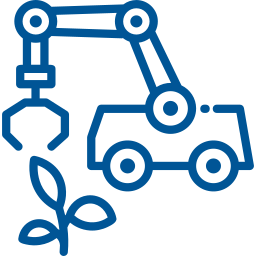-
Use Case: Agriculture Robotics are used in smart farming to collect high-resolution field data using ground-based or aerial based sensors which is collected into a central advisory unit. The data is interpreted, and information is extracted to provide decisions and actions to the field robots. Agricultural field robots are used for tilling, soil analysis, seeding, transplanting, crop scouting, pest control, weed removal and harvesting (identify ripe versus unripe plants):
Some of the key agriculture robotics applications fit into the following sub-categories:
- Field scouting and data collection - process of continuously monitoring the field to acquire information on the plant status, disease incidence, and infestations affecting crop growth.
- Precision Weed Control and targeted spraying
- Automated Crop Harvesting
- Planting and SeedingDevice(s)
Camera types used on agrobots:
- RGB cameras - extensively used in agricultural machine vision
applications for fruit/plant detection, yield prediction, segmentation
tasks, disease detection, ripeness detection, weed detection and insects' detection
- Hyperspectral, thermal, or ultrasonic cameras - typically provide better results than conventional RGB color images
- Stereoscopic cameras - provides 3D plant structure information (Dimension of crops (depth information, crop height, leaf shape, leaf area etc.))
Critical factor is the camera’s resolution, which should be high enough to capture the details of the scene especially in the cases of insect and disease detection. [1]Efthimia Mavridou, Eleni Vrochidou, George A. Papakostas *, Theodore Pachidis and Vassilis G. Kaburlasos, “Machine vision Systems in Precision Agriculture for Crop Farming”, Journal of Imaging, 7 December, 2019.
https://doi.org/10.3390/jimaging5120089KPIs
E2E Latency: Best effort Jitter: Not Sensitive Data Rate: Low: < 10 Mbps Availability: Medium: 90 - 95% Criticality: Non critical Communication Direction: Two-way Common Communication Mode: Unicast Data Reporting Mode: Hybrid Driven Notes: Hybrid-BasedMobility (type/speed): Pedestrian Service Continuity: Not Required Device Autonomy (Power Constrained): Yes Connectivity Type: WAN - Cellular, LPWA, Satellite Priority Services (NS/EP): No (it would not) Guaranteed Service: GBR Security: Medium Lifespan: Long: More than 8 years Device Density: Low (<1000) Location Based Services: Very High Accuracy (less than 1M) Slice Type Slice Type: HMTC GPS for autonomous navigation in open-field cultivation environments Robotic data collection platform equipped with RADAR, liDAR, ultrasonic radar sensors, spectrometers, fluorometers.KPIs
E2E Latency: Moderate: 10ms-100ms Jitter: Not Sensitive Data Rate: Very Low: <100kbps Availability: Medium: 90 - 95% Criticality: Non critical Communication Direction: Two-way Common Communication Mode: Unicast Data Reporting Mode: Hybrid Driven Mobility (type/speed): Pedestrian Service Continuity: Not Required Device Autonomy (Power Constrained): Yes Connectivity Type: WAN - Cellular, LPWA, Satellite Priority Services (NS/EP): No (it would not) Guaranteed Service: GBR Security: Medium Lifespan: Long: More than 8 years Device Density: Low (<1000) Location Based Services: Very High Accuracy (less than 1M) Slice Type Slice Type: HMTC

